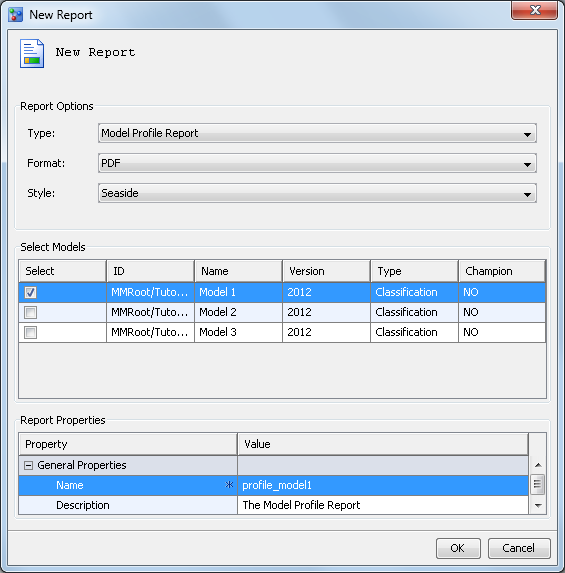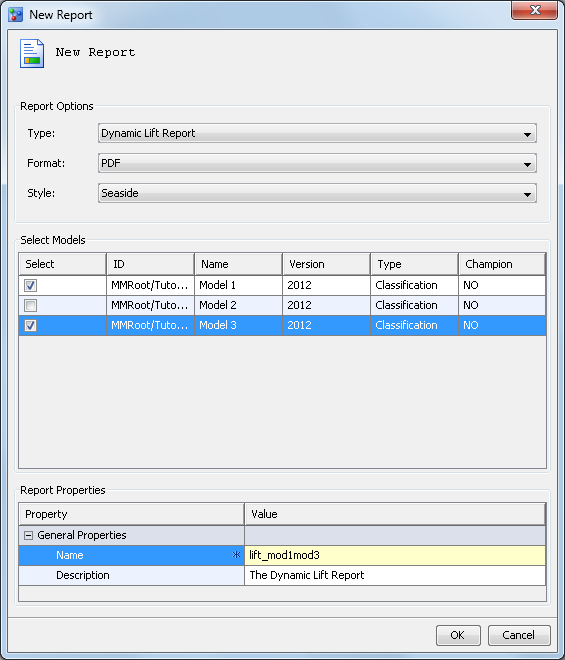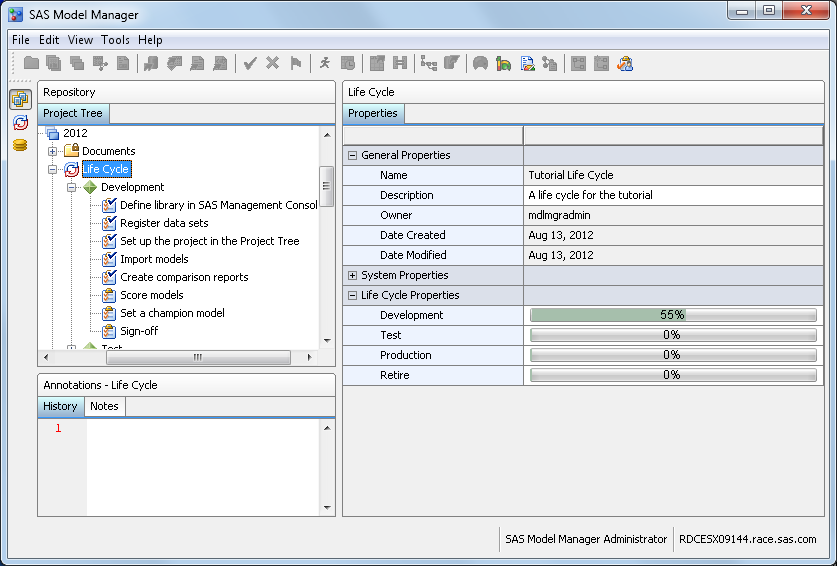Create Model Comparison Reports
In this exercise, you create several model comparison
reports that are used in the selection and approval of a champion
model. After you create the reports, you view the reports in the Reports folder.
The reports enable you to evaluate candidate models in a version or
across versions by assessing the structure, performance, and resilience
of your models.
Create a Model Profile Report
The Model Profile report
creates three tables to display the profile data that is associated
with the model input variables, output variables, and target variables.
To create this report, follow these steps:
-
Expand the
2012 version
in the
Delinquency project and right-click
the
Reports folder. Then select
Reports New Report
New Report. The
New Report window appears.
-
In the
New
Report window, use the specified values for these fields
and click
OK:
Type
select Model
Profile Report.
Format
select PDF. PDF is
the default value, and it might already be the value for Format.
Style
select Seaside. SAS
default is the default style for the SAS format that
is selected. For example, the default style for the HTML format is
HTMLBLUE.
Select Models
select the box for Model
1.
Report Properties
replace the default
report name with the report name profile_model1 in
the Name field.
Here is the
New
Report window at this point in the process. Click
OK when
you are finished.
-
When the information
dialog box confirms that the report was created successfully, click
Close.
Create a Delta Report
The Delta report compares
the profile data for two models and notes the differences. To create
this report, follow these steps:
-
Expand the
2012 version
in the
Delinquency project and right-click
the
Reports folder. Then select
Reports New Report
New Report. The
New Report window appears.
-
In the
New
Report window, use the specified values for these fields
and click
OK:
Style
select SAS
default. SAS default is the
default style for the SAS format that is selected. For example, the
default style for the HTML format is HTMLBLUE.
Select Models
select the boxes for Model
1 and Model 2.
Report Properties
replace the default
report name with the report name delta_mod1mod2 in
the Name field.
Here is the
New
Report window at this point in the process. Click
OK when
you are finished.
-
When the information
dialog box confirms that the report was created successfully, click
Close.
Create a Dynamic Lift Report
The Dynamic Lift report
provides visual summaries of the performance of one or more models
for predicting a binary outcome variable performance. To create this
report, follow these steps:
-
Expand the
2012 version
in the
Delinquency project and right-click
the
Reports folder. Then select
Reports New Report
New Report. The
New Report window appears.
-
In the
New
Report window, specify the following options and click
OK:
Type
select Dynamic
Lift Report.
Style
select Seaside. SAS
default is the default style for the SAS format that
is selected.
Select Models
select the boxes for Model
1 and Model 3.
Report Properties
replace the default
report name with the report name lift_mod1mod3 in
the Name field.
Here is the New Report
Wizard at this point in the process. Click
OK when
you are finished.
-
When the information
dialog box confirms that the report was created successfully, click
Close.
View a Model Comparison Report
To view a model comparison
report, follow these steps:
-
Expand the version folder
2012 and
the
Reports folder.
-
Right-click the report
name and select
View Report.
Note: If user credentials are
required, then specify a user ID and password that have permission
to access the SAS Content Server.
-
Use the PDF viewer to
distribute or print a copy of the report.
-
For a detailed description
of the model comparison reports, see the
SAS Model Manager: User's Guide.
Update the Life Cycle (Optional)
To update the Development
milestone, follow these steps:
-
In the
Delinquency project,
expand
2012 Life Cycle
Life Cycle Development
Development.
-
Select the
Create
comparison reports task. Select the
Status box
and select
Completed.
-
Select
Create
comparison reports. The
Completed Date and
Completed
By fields have been updated with today's date and your
user ID.
-
Click the
Life
Cycle node to examine its properties. The value for
Date
Modified is today's date. The
Development property
displays a bar chart that shows the percentage of completed tasks
for this milestone.
Update the Workflow Process (Optional)
To complete the activities
in the associated workflow process, follow these steps:
-
Select
Tools My Workflow Inbox
My Workflow Inbox or click

from the SAS Model Manager main window to view the
workflow process activities in your workflow inbox. Workflow Console
is launched in a Web browser, and displays the Activities category
view.
Note: The list displays only the
activities for which you are the actual owner or are assigned as a
potential owner, and that have the state of
Started.
-
From the
Activities category
view, select an activity name, and click

.
Note: You can select an activity
name and click

to release an activity that you had previously claimed.
-
(Optional) Enter a property
value or change an existing property value in the
Properties pane.
-
(Optional) Add a comment
to the activity using the
Comments pane.
-
Select a status value
to complete the activity. The workflow process continues to the next
activity.
-
Repeat steps 2 through
5 for the activities that you completed during this tutorial.
Note: A workflow can be configured
to display the activities that are associated with a milestone or
task on the
Workflow Milestones tab and in
the Workflow Milestones report for a version in the SAS Model Manager
client application. From the
Workflow Milestones tab
you can view the status of milestones or tasks that are associated
with activities in the workflow.
Copyright © SAS Institute Inc. All rights reserved.








